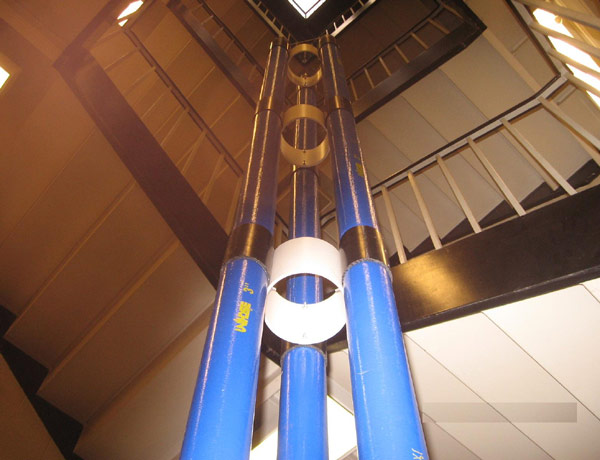Scientists envision inflatable alternative to tethered space elevator

An inflatable free standing tower could one day carry equipment and tourists 20 kilometers above Earth, and it could be completed much sooner than a cable-based space elevator, say researchers at York University in Toronto, Canada.
They envision a giant tower assembled with a series of modules made up of Kevlar-polyethylene composite tubes that would be made rigid by inflating them with a lightweight gas such as hydrogen or helium. This would actively stabilize the giant tower and allow for flexibility. The elevator would support a series of platforms or pods that would launch payloads into Earth orbit.
”You can visualize it as a system of nesting segments that roll out vertically and snap into position, much like a telescoping wand,” Seth said in a news article. “You’re not constructing externally, but rather, from internally.”
To test the idea, the team built a 7-meter scale model made up of six modules (see image below).
According to a post in New Scientist, the demonstration model consists of modules built out of three laminated polyethylene tubes 8 centimeters in diameter, mounted around circular spacers and inflated with air. The 20-kilometer version (15 kilometers tower atop a 5 kilometer mountain) would be made up of 100 modules, and would weigh 800,000 metric tons when pressurized.
The full scale structure would also require gyroscopes and active stabilization systems in each module to help it stay upright and withstand winds which could be coming from any number of directions simultaneously across the vertical span of the tower.
The team led by Brendan Quine came up with the idea while investigating an alternative to the use of rockets to get payloads into space but that would also overcame the technological challenges of envisaged space elevators based on tethers (image).
The problems with a space tether include material strength constraints, the need for in-space construction, the fabrication of a cable at least 50,000 km in length, and the aging and meteorite-damage effects associated with a thin tether or cable in Low Earth Orbit. Not to mention the envisaged use of ribbons woven from super strong nanotubes, which is a material that is as yet non-existent. The York inflatable tower, on the other hand, would use materials that are already available.
The team has filed for international patent protection for their design, in partnership with space technology company, Thoth Technology Inc. They hope to realize the dream of a space elevator with the next decade.
A paper (paid access req.) detailing the design, was recently published in the journal Acta Astronautica Volume 65, Issues 3-4, August-September 2009, Pages 365-375; it is co-authored by George Zhu, Assistant Professor of Space Engineering, and graduate student Raj Seth. it discusses the stability and control of the structure, methods for construction and its utility for space launch and other applications.
